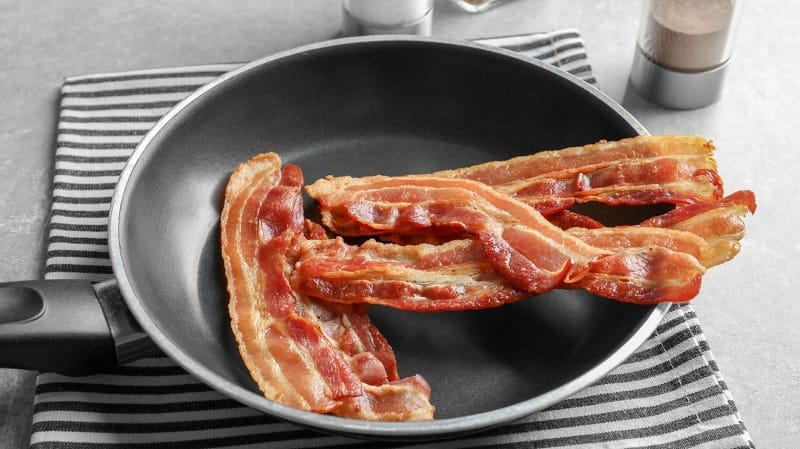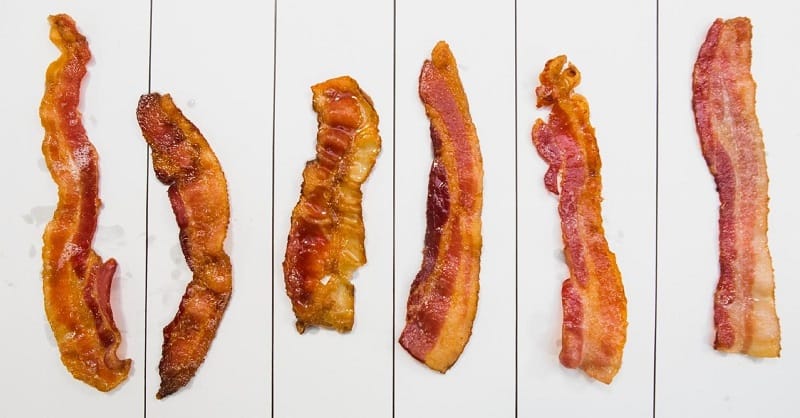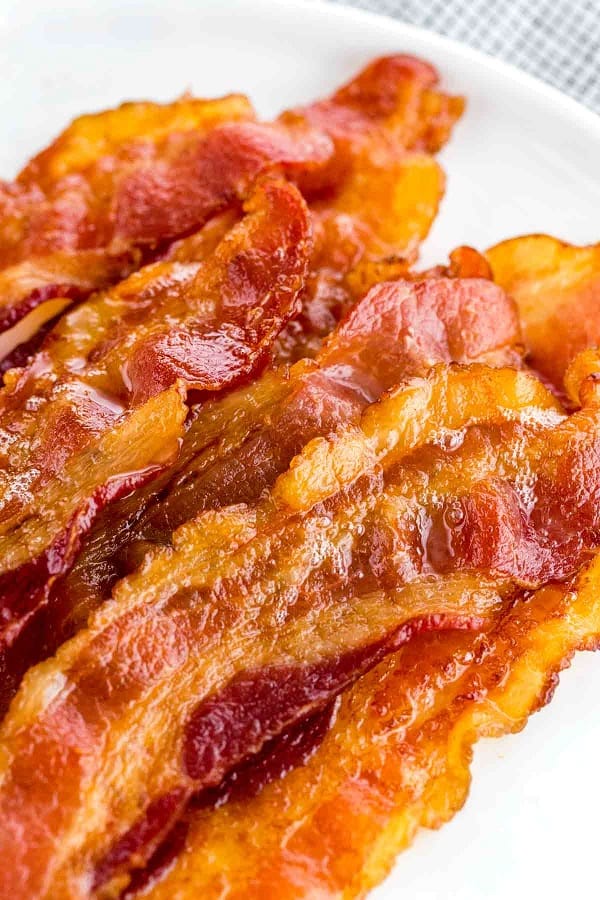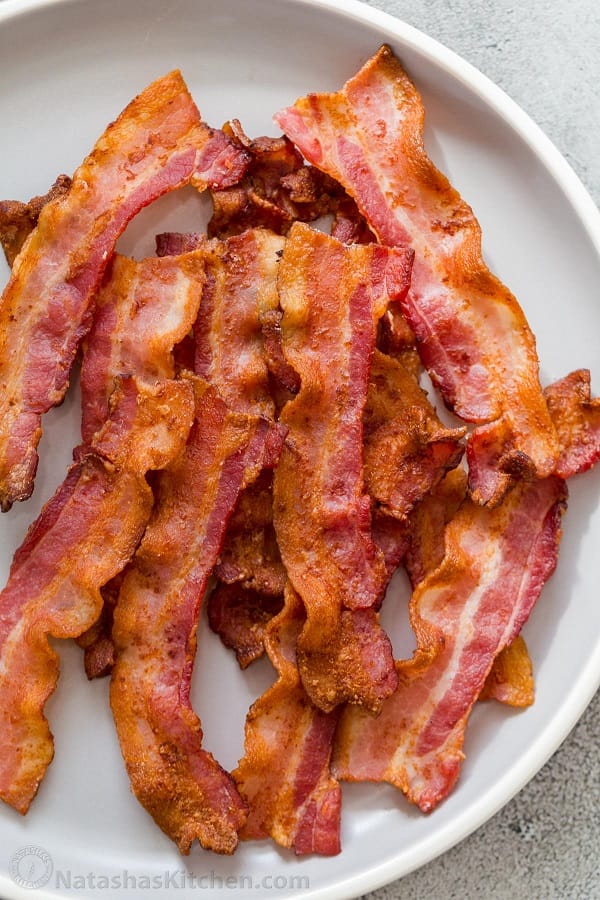Cooked bacon is a popular breakfast staple, but how long can cooked bacon sit out before it becomes unsafe to eat? It’s important to understand the risks associated with consuming food that has been left out too long. This article will help you learn more about food safety when it comes to cooked bacon, including how long it can safely sit out and other tips for keeping your family safe. Read on to find out more about how long cooked bacon can remain at room temperature without becoming a risk to your health.
What is Cooked Bacon?

As a lover of all things bacon, I often find myself wondering about the different types of bacon out there and how they’re made. One type that I’ve always been curious about is cooked bacon. So, what exactly is cooked bacon?
Simply put, cooked bacon is bacon cooked until it is crispy and browned. But there’s more to it than just that. Cooked bacon can be made from different cuts of pork and cooked using various methods.
The most common cut of pork used for cooked bacon is pork belly. This cut is known for its fatty layers, giving the bacon a rich flavor and crispy texture. However, other cuts, like pork loin or Canadian bacon, can also be used to make cooked bacon.
The cooking method for cooked bacon can also vary. Some people prefer to oven-bake their bacon, while others fry it on the stove. Regardless of the method used, the goal is always to cook the bacon evenly and to the desired level of crispiness.
One thing to keep in mind when cooking bacon is that the fat content can cause it to splatter and make a mess. Some people cook bacon in the oven using a baking sheet lined with parchment paper or aluminum foil to prevent this.
So, why do people love cooked bacon so much? For starters, it’s incredibly versatile. Cooked bacon can be eaten as a snack, added to sandwiches, salads, and pizzas, or used as a topping for burgers or hot dogs. It’s also a staple in breakfast dishes like eggs and bacon, pancakes and bacon, and bacon and sausage gravy.
How Long Can Cooked Bacon Sit Out?
According to experts, cooked bacon should not be left at room temperature for more than 2-3 hours, especially if your kitchen is warm. If you’re not going to eat all of your bacon in one sitting, it’s best to store it in the fridge for later. Bacon lasts longer than other meats, especially cured bacon, due to the added salt. However, fresh bacon should not be left out for too long.
There are a few options to reheat cooked bacon, such as baking it in the oven or microwaving it. If cooked bacon has gone bad, it will give off a sour smell, lose its pink color, and may have black or white mold spots. Consuming bad bacon may make you sick due to harmful bacteria like salmonella. Therefore, it’s best to throw it away if you have doubts about its freshness.
How Long Does Cooked Bacon Last in the Refrigerator?

Cooked bacon can last up to 5 days in a sealed container, zip-top plastic bag, or airtight bag as long as it’s not past its original expiration date. However, USDA guidelines suggest it can be refrigerated for up to 7 days. It’s best to use airtight containers and remove as much surface area as possible to reduce the risk of spoilage and preserve its flavor.
The shelf life of bacon depends on its type, thickness, and how thoroughly it is cooked. Home-cooked bacon bits made from real bacon should be refrigerated in an airtight container and can last up to 5 days. The ideal temperature for refrigerating bacon is 40 degrees F or lower. To ensure the safety of bacon, it’s crucial to check the package for use-by or sell-by dates and ensure it’s sealed properly before purchasing it.
How Long Does Cooked Bacon Last in the Freezer?
When storing cooked bacon, there are a few things to keep in mind to ensure its safety and maximum flavor. Regarding freezing, cooked bacon can be stored in the freezer for up to six months. To freeze cooked bacon, it’s important to get it into the fridge or freezer quickly after cooking to avoid any bacteria growth. Place the cooked bacon in an airtight zip-top freezer bag and label it with the date before putting it in the freezer.
To thaw frozen bacon, let it thaw in the fridge overnight before gently warming it in any recipe or microwaving it for 30 seconds. If cooked bacon has been left out for longer than two hours, it’s best to toss it to avoid any risk of illness.
How Long Can Cooked Nitrate-Free Uncured Bacon Sit Out?
Despite being healthier than traditional bacon, nitrate-free uncured bacon has a shorter shelf life. Typically, cooked bacon should not be left out for more than two hours after cooking, especially in temperatures above 90°F, where bacteria growth is highest. After two hours, the bacon can become tainted with so many bacteria that it is no longer safe to consume.
If the bacon has a rancid smell or feels slimy, it is spoiled and should be discarded immediately. If left at room temperature, the bacon may develop a rancid odor. Although it is suggested that cured bacon may last a little longer unrefrigerated, it is still recommended to refrigerate any leftover cooked bacon. Overall, it is best to consume bacon immediately after cooking or, if stored, to refrigerate it within two hours.
Read more:
What Temperature Should Cooked Bacon Be Stored At To Prevent It From Going Bad?

To prevent cooked bacon from going bad, the recommended temperature for storage is 40 degrees Fahrenheit or below. Whether stored in the refrigerator or freezer, it is essential to ensure that the bacon is cooled adequately before being transferred to an airtight container or bag.
Keeping cooked bacon fresh and safe for consumption requires proper handling and storage methods, including short-term storage in the oven or using a breathable towel, medium-term storage in the refrigerator for up to five days, and long-term storage in the freezer for up to six months.
What Are The Main Factors That Affect How Long Cooked Bacon Can Sit Out?
We all know that bacon is a perishable item, but there are times when we forget to put it away or want to keep it out for longer. So, what are the main factors that affect how long cooked bacon can sit out?
First and foremost, the room’s temperature can significantly impact the lifespan of your bacon. According to the USDA, cooked bacon should not be left at room temperature for more than two hours. This is because bacteria can grow rapidly between the temperatures of 40°F and 140°F, and leaving your bacon out for too long can make it unsafe to eat. So, if the room temperature is above 90°F, your bacon should not be left out for more than one hour.
Another factor that can affect how long cooked bacon can sit out is the moisture level. If your bacon is left out in a humid environment, it can become a breeding ground for bacteria. This is why storing your bacon in a dry and cool place is essential. If your bacon is left out in a humid environment, it can become slimy and develop an unpleasant odor, which can be a sign that it has gone bad.
The packaging your bacon comes in can also affect how long it can sit out. If your bacon is vacuum-sealed, it can last longer than bacon that is not. This is because the vacuum-sealed packaging prevents air from coming into contact with the bacon, which can help to slow down the growth of bacteria.
Lastly, the quality of your bacon can also affect how long it can sit out. If your bacon is of high quality and properly cooked, it can last longer than bacon of lower quality. However, if your bacon is of lower quality or has not been cooked properly, it can spoil much faster and should not be left out for long periods.
How Does Bacterial Growth Affect Cooked Bacon Left Out At Room Temperature?

When food is left out at room temperature, it creates the perfect environment for bacteria to grow. This is especially true for meat products like bacon, which are rich in protein. Bacteria love protein and will happily multiply on any surface that provides it.
So, what does this mean for your delicious cooked bacon? Well, if you leave it out at room temperature for too long, you run the risk of it becoming contaminated with harmful bacteria. These bacteria can cause nasty illnesses, from food poisoning to more serious conditions like listeria.
To give you an idea of how quickly bacteria can grow on cooked bacon left out at room temperature, let’s look at the numbers. According to the USDA, perishable food should not be left at room temperature for more than two hours. If the temperature in your home is particularly warm, this time frame may be even shorter.
During these two hours, bacteria can multiply rapidly. It only takes about 20 minutes for the number of bacteria on a surface to double! This means that if you leave your cooked bacon out for just two hours, the number of bacteria on it could have multiplied by a factor of 16.
In conclusion, while leaving your cooked bacon out at room temperature for a quick snack later on, may be tempting, it’s important to remember that this can be a breeding ground for harmful bacteria. If you want to keep your bacon safe to eat, store it properly in the fridge or freezer and avoid leaving it at room temperature for too long.
What Are Some Signs That Cooked Bacon Has Gone Bad And Should Be Thrown Away?
It’s important to know when it’s time to say goodbye and throw away any bacon that has gone bad. Here are some signs to look out for:
- Foul smell: One of the easiest ways to tell if your cooked bacon has gone bad is by sniffing it. If it smells rancid or sour, it’s time to toss it. Fresh bacon should have a savory and smoky aroma, so any deviation from that is a clear indicator that it has gone bad.
- Slimy texture: Bacon should be slightly greasy but never feel slimy. If your cooked bacon has a slimy texture, it’s a sign that bacteria has started to grow on it. This is a surefire sign that it’s time to throw it away.
- Mold spots: Mold is a clear sign that your food has spoiled and should be thrown away immediately. Check your bacon for any signs of mold, which can appear as small black or green spots. Even if the mold is only on one piece of bacon, it’s best to throw away the entire batch to be safe.
- Change in color: Cooked bacon should have a reddish-brown color, but if it starts to look gray or brown, it’s a sign that it has gone bad. Additionally, if you notice any discoloration on the bacon, such as green or white spots, it’s time to toss it.
- Taste: If you’re unsure whether your cooked bacon has gone bad, you can take a small bite to test the flavor. It’s time to throw it away if it tastes sour or off. Fresh bacon should have a salty and savory taste, so any deviation from that is a clear sign that it has gone bad.
Health Risks Associated With Consuming Cooked Bacon Spoilage?

I have often wondered about the health risks associated with consuming cooked bacon spoilage. While it may seem like a minor concern, the truth is that eating spoiled bacon can have serious consequences for your health.
First and foremost, consuming spoiled bacon can lead to food poisoning. This is because bacteria can grow on the meat if it has not been appropriately stored or left out for too long. Symptoms of food poisoning can include nausea, vomiting, diarrhea, and stomach cramps, and can be particularly dangerous for young children, pregnant women, and the elderly.
In addition to the risk of food poisoning, consuming spoiled bacon can also increase your risk of developing other health problems. For example, eating too much bacon can lead to high cholesterol levels, leading to heart disease and stroke. Furthermore, bacon contains high levels of sodium, which can increase your blood pressure and put you at risk for hypertension.
Of course, it’s not all bad news. Bacon can still be enjoyed in moderation as part of a healthy diet. However, it’s essential to be aware of the risks associated with consuming spoiled bacon and take steps to minimize exposure. This means storing bacon in the refrigerator or freezer immediately after purchasing it and cooking it thoroughly before consuming it.
How Do I Thaw Frozen Cooked Bacon?

Here are a few simple steps that I follow to get that delicious bacon back to its original state.
- Step 1: Take the bacon out of the freezer and place it in the refrigerator. This is the safest way to thaw bacon as it prevents the growth of harmful bacteria. Depending on the amount of bacon you have, it can take anywhere from a few hours to overnight to thaw.
- Step 2: If you’re in a hurry and unwilling to wait for hours, you can use the microwave to thaw the bacon. Place the bacon on a microwave-safe plate and cover it with a paper towel. Set the microwave to defrost mode and heat the bacon in 30-second intervals. Flip the bacon over after each interval until it is thawed.
- Step 3: If you’re not a fan of microwaves, you can also thaw the bacon by placing it in a bowl of cold water. Make sure that the bacon is in a sealed plastic bag or wrapped tightly in foil to prevent water from seeping in. Change the water every 30 minutes until the bacon is fully thawed.
- Step 4: Once the bacon is thawed, it’s ready to be reheated. You can microwave it for a few seconds or place it in a preheated oven at 350°F for five minutes until it’s crispy.
How to Store Cooked Bacon?
Here are some tips for storing cooked bacon:
- Let it cool completely: Before you even think about storing your bacon, you must let it cool. This will prevent any moisture from forming and will help keep it crispy.
- Store in an airtight container: Once your bacon is cool, place it in an airtight container. This could be a Tupperware container, a Ziploc bag, or even a mason jar. The key is ensuring no air is getting in, which will help prevent moisture from forming.
- Refrigerate or freeze: If you plan on eating your bacon within a few days, you can store it in the fridge. Just make sure it’s in an airtight container and that it’s not touching any other food. If you want to store it for a longer period of time, consider freezing it. You can freeze bacon for up to six months, and it will taste great.
- Label and date: If you’re storing your bacon in the fridge or freezer, label and date it. This will help you track how long it’s been in there and will prevent any confusion about what it is.
- Reheat properly: When ready to eat your bacon, reheat it properly. You can do this in the microwave, on the stovetop, or in the oven. Just make sure to watch it closely, as it can burn easily.
How to Reheat Cooked Bacon?

I know how important it is to reheat cooked bacon perfectly, and I have some foolproof methods to reheat your favorite breakfast meat.
Method 1: Microwave
Microwaving is the quickest and easiest way to reheat bacon. Place the cooked bacon on a microwave-safe plate and cover it with a paper towel. Microwave on high for 20-30 seconds, depending on the thickness of the bacon. Check after every 10 seconds to avoid overcooking.
Method 2: Oven
The oven method is perfect if you’re reheating a larger quantity of bacon. Preheat your oven to 350°F and line a baking sheet with parchment paper. Place the bacon on the baking sheet and bake for 5-10 minutes or until heated.
Method 3: Skillet
This method is ideal if you want your bacon to be crispy. Heat a skillet over medium heat and add the cooked bacon. Cook for 1-2 minutes on each side or until heated through and crispy.
Tips:
- Avoid reheating bacon in the microwave for too long, as it can become rubbery.
- If you’re using the oven method, oversee the bacon to prevent burning.
- Use a non-stick skillet to prevent sticking if you reheat bacon on the stove.
In conclusion, reheating cooked bacon is a simple task if you follow these methods. Whether you prefer a microwave, oven, or skillet, you can enjoy crispy and delicious bacon in just a few minutes.
FAQs
Is It Safe To Eat Cooked Bacon That Has Been Left Out Overnight?
Based on factual data, eating cooked bacon left at room temperature for over two hours is not recommended. Bacteria can easily contaminate it, leading to food poisoning and indigestion. To avoid this, storing leftover cooked bacon in an airtight container in the fridge as soon as it cools down is best. It is essential to check the expiry date of any bacon before purchasing to avoid consuming expired meat. Therefore, better safe than sorry; it is best to throw away any suspicious-looking meat and not take a chance with your health.
Can You Cook Bacon Ahead and Reheat It?
Cooking bacon and reheating it is a great time-saving hack for busy individuals and families. There are several ways to cook the bacon ahead, but one of the easiest and most hassle-free options is to make it in the oven. This method eliminates the mess, smoke, and grease associated with stovetop cooking allowing you to cook a large batch simultaneously.
Bacon lasts up to 4-6 months when properly stored in the freezer and can be reheated in the microwave for quick meals or snacks. Bacon goes well with almost anything, from mac ‘n cheese and potato salad to salads and soups. Cooking bacon ahead and reheating it is a simple and convenient way to save time and add flavor to any meal.
What Is The Temperature Danger Zone, And How Does It Affect Food Safety?
The temperature danger zone is a range of temperatures in which bacteria thrive and grow rapidly, resulting in food being unsafe for consumption. The USDA states this danger zone is between 40°F to 140°F (4-60°C). Therefore, keeping perishable foods, such as meat, seafood, dairy, and cooked leftovers, at refrigerated temperatures of 40°F or below or frozen at 0°F or below is essential.
Failure to do so can allow dangerous bacteria to grow, potentially causing food poisoning and related illnesses. It is advisable to keep track of the storage duration of perishable foods in the refrigerator and freezer, as they can spoil over time. Additionally, it is crucial to cook food appropriately to kill off harmful bacteria. Maintaining proper food storage temperatures, whether at home or in a restaurant, is necessary for food safety. Above all, preventing the growth of bacteria in food is paramount.
What Are The USDA Guidelines For Cooked Bacon Storage?
The United States Department of Agriculture (USDA) provides guidelines on how to store cooked bacon properly.
- Once the bacon is cooked, it should be refrigerated in an airtight container and kept at 40°F or below.
- Shelf-stable bacon can be stored at or below 85°F, but it is recommended to refrigerate it after opening.
- It is important not to leave cooked bacon at room temperature for more than two hours as bacteria can rapidly grow in temperatures above 40°F.
- Cooked bacon should be thrown out if it is kept at room temperature for longer than two hours.
- Cooked bacon can also be stored in the freezer and will last up to a month if it is unopened.
- It is important to check the product label for handling instructions and follow the manufacturer’s recommended “use-by” date.
- Additionally, cooked bacon strips should cool completely on a wire rack before being stored in an airtight bag or container to prevent spoilage.
- Home-cooked bacon bits should be stored in an airtight container in the refrigerator and will last up to five days.
- The ideal temperature for refrigerating bacon is 40°F or lower, and any doubts about a fridge’s cooling ability can be checked with a thermometer.
- It is important to remember to select refrigerated cooked bacon just before checking out at the supermarket register.
Following these USDA guidelines, cooked bacon can be safely and deliciously enjoyed for up to five days.
How Does Cross-Contamination Impact The Safety Of Cooked Bacon?
Cross-contamination poses a significant risk to the safety of cooked bacon. The transfer of harmful bacteria from raw meats to cooked foods can result in foodborne illnesses, with cooked bacon being no exception. In particular, bacteria such as Salmonella, Campylobacter, and Listeria can survive on surfaces and equipment for long periods, leading to cross-contamination.
This is especially concerning in food preparation settings with increased handling of raw meat products. Additionally, reusing kitchen utensils, cutting boards, and storage containers without proper washing can increase the risk of cross-contamination.
To ensure that cooked bacon remains safe, following food safety protocols such as washing hands thoroughly, separating raw meats from ready-to-eat foods, and sanitizing all surfaces between handling different food items is essential. Practicing these steps can minimize the potential risks of cross-contamination and help guarantee the safety of cooked bacon, preventing potentially harmful and dangerous foodborne illnesses.
How Long Can Cooked Bacon Sit Out – Final Thoughts
In conclusion, cooked bacon should not be left at room temperature for more than 2 hours. If you have leftover bacon, store it properly in the refrigerator or freezer to ensure its safety and freshness. Remember always to follow safe food handling practices to avoid potential foodborne illnesses.
Do you have any questions about how long can cooked bacon sit out? Let us know in the comments below.
References:
- https://www.ncbi.nlm.nih.gov/pmc/articles/PMC3717613/
- https://www.safefood.net/food-safety/cross-contamination
- https://justcook.butcherbox.com/can-you-freeze-cooked-bacon/

Hey readers! Chip Holland here, and I’m a Manager of this website. My passion for writing about it only matches my passion for BBQ. Follow my blog for mouth-watering recipes, tips, and tricks for the perfect smoke, grill, and BBQ. I’m sure you won’t be disappointed!
